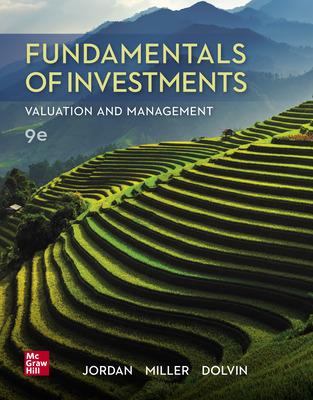Answered step by step
Verified Expert Solution
Question
1 Approved Answer
the first photo is the Prompt below sre 2 questions please complete both, with explanation if possible Tail risk is the chance of a loss
the first photo is the Prompt below sre 2 questions please complete both, with explanation if possible 

Tail risk is the chance of a loss occurring due to a rare event or a series of rare events. Tail risk is like a black swan: you may not see it every day, but it does exist. Value-at-Risk (VaR) is a popular tool used to measure tail risk. Use the same assumptions above. What is the worst-case scenario that we may face in one trading day given 1% chance? Since the portfolio daily return follows a normal distribution, we can calculate that the VaR at 1% is -36.53%. You may think that 1% chance is very rare. However, it could happen and as a portfolio manager you need to monitor the tail risk. It is also a common belief that the return of the financial assets has fat tails. It means that the actual loss will be greater than -36.53%. How about instead of having one bad day, we may face consecutive bad days? What is the probability that we will lose 10% for three consecutive days? Assume that the portfolio daily return follows a normal distribution with a mean equal to 10%, and a standard deviation equal to 20%. The probability that we will lose more than 10% for one trading day is 15.87%. Assume that the asset return is independent in each trading day, the probability that we will lose more than 10% for three consecutive days is 15.87%3 = 0.399%. We know that the actual return of financial assets is not time-serially independent but serially correlated. Therefore, the actual probability is much higher that 0.399%. Why is this important? Highly levered trading is extremely vulnerable to tail risk. Consider the following scenario. Scenario C Initial Margin 35% Leverage Used 65% Requirement Margin 30% In this case, if you have three days with more than 2% loss, you will face a margin call. What is the probability that this will happen? The probability that we will lose more than 2% for one trading day is 27.43%. Assuming that the asset return is independent in each trading day, the probability that we will lose 2% for three consecutive days is 27.43%3 = 2.063%. Now you can see it is not something unimaginable (especially in real market the asset return is serially correlated). a Q5. If your portfolio margin requirement is 40%, and the initial margin is 70%. Assume that the portfolio daily return follows a normal distribution with a mean equal to 12%, and a standard deviation equal to 18%, what is the daily VaR at 5%? Q6. From the reading materials, is tail risk a main factor of the failure for Archegos Capital Management? If so, can you identify a series of bad events happened to the fund? Hint: identify the stocks held by Archegos that had rare but bad events and resulted in big loss 

Step by Step Solution
There are 3 Steps involved in it
Step: 1

Get Instant Access to Expert-Tailored Solutions
See step-by-step solutions with expert insights and AI powered tools for academic success
Step: 2

Step: 3

Ace Your Homework with AI
Get the answers you need in no time with our AI-driven, step-by-step assistance
Get Started


